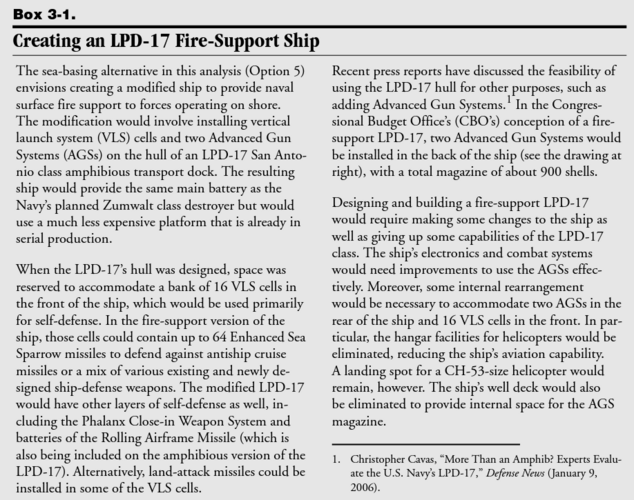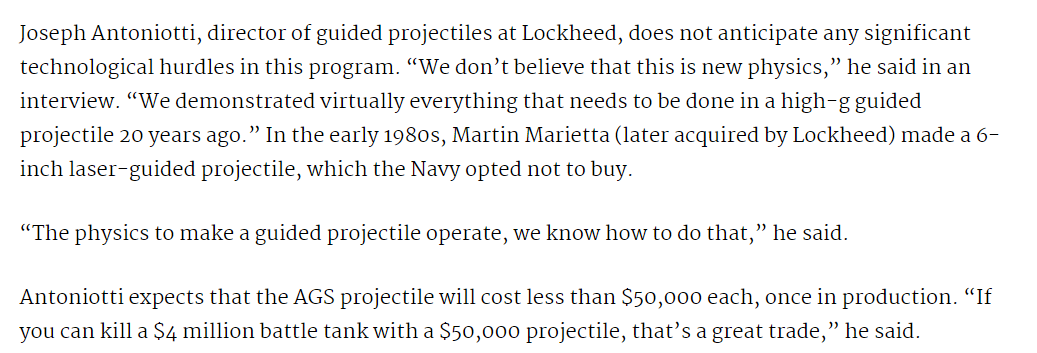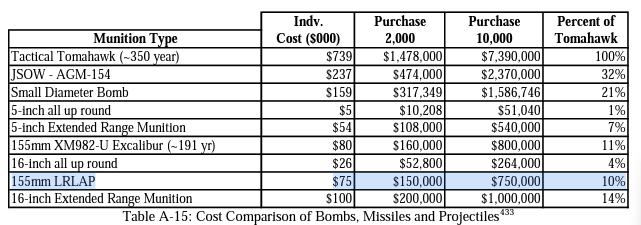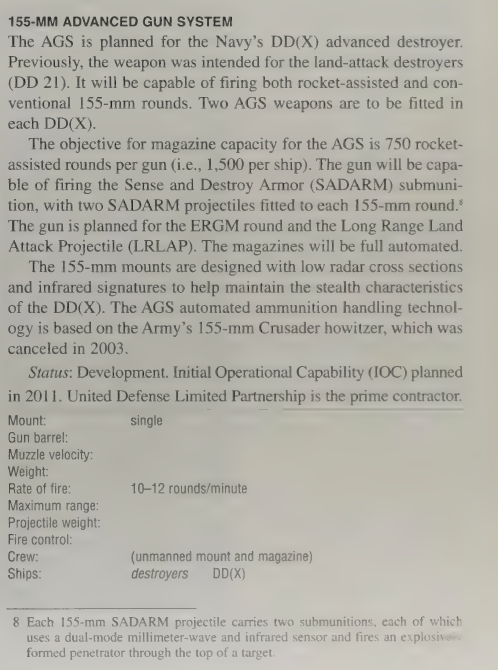Model of BAE Systems 155-mm Advanced Gun System - Lite (AGS-L) on display at Navy League Air Sea Space Exposition 2013.
Source:
PDF of sale brochure for BAE Systems AGS-L:
Source:
PDF of sale brochure for BAE Systems AGS-L:
TomS said:Interesting that BAE are still referring to the seemingly mythical unguided 155mm ASuW Projectile. They've been talking about it for years, but there's no sign they've actually developed it.
RP1 said:Unguided? I remember an RO paper from 2001 with a sub-munitions-dispensing ASuW 155mm projectile?
Sea Skimmer said:Frankly it isn't a great loss, in view of how rarely naval gunfire is ever used it may well be cheaper or at least no vast cost increase to fire large numbers of GPS guided rounds in wartime, while saving the expenditure of large numbers of unguided shells in regular training over the forty year lifespan of the ship (think we'll shoot unguided shells in 2050?). They are cheap but they aren't free either. The effective ban on new DPICM rounds, and coming deadline to phase out existing ones already considerably undermined the value of small numbers of unguided 155mm rounds from a warship, and in the early part of the new century it became pretty clear that the Congressionally mandated 1% or less dud rate could not be met which is when LRLAP itself lost its cluster warhead. At least not as long as unarmed duds were counted the same as armed duds or without some radical breakthrough in fusing technology.
sferrin said:That round 2nd from the right looks interesting. Almost like it's got a booster on it.
Void said:What is unusual though is the length. It is visibly longer than the 1.5m long 5 inch Standard Guided Projectile (2nd and 3rd from the left).
Denel's 155mm ERFB shells are only about 850mm long. The mystery shell looks about twice their length.
Why is the AGS (155mm) so much heavier than the mark 45? (104t vs 21t respectively)
Even the Mk71 (203mm) was only 78t.
I assume that the super long shell is the LRLAP? And the shell on the (edit) far right is the "standard" BAE GPS-guided 155mm shell?
Is this a mockup of the ASuWP perhaps?

Once helicopters joined the fleet, it became apparent that we could keep the amphibs well off shore. There was no reason to risk running into a minefield for a land-based ASM battery.Gotta admit, I have always wondered why the 'phibs never had any significant shore bombardment capabilities designed in...
Early Phibs had some 5" guns that were more for self defense than shore bombardment, which basically got removed in the 1990s. But only 6x guns in single turrets.
Excellent point. And kinda what killed the EFV planing-hull amtrack. Cheap coastal defenses got more range quickly enough that even a 30+kt amtrack couldn't get the big 'phibs out of range.Once helicopters joined the fleet, it became apparent that we could keep the amphibs well off shore. There was no reason to risk running into a minefield for a land-based ASM battery.
I'm not so sure about TLAMs on the San Antonios, but I'd believe ESSM and SM2 (assuming that the Tonis have radar capable of illuminating for them, or that there's finally an SM2 active homing version).It should be noted though that the Tarawas where designed with 5” guns, there was consideration to put ABRS on the Newport LSTs, and the San Antonios where designed with 16 VLS cells, presumably for ESSM and TLAMs.
The design logic supposedly went something like:Excellent point. And kinda what killed the EFV planing-hull amtrack. Cheap coastal defenses got more range quickly enough that even a 30+kt amtrack couldn't get the big 'phibs out of range.
I'm not so sure about TLAMs on the San Antonios, but I'd believe ESSM and SM2 (assuming that the Tonis have radar capable of illuminating for them, or that there's finally an SM2 active homing version).
Excellent point. And kinda what killed the EFV planing-hull amtrack. Cheap coastal defenses got more range quickly enough that even a 30+kt amtrack couldn't get the big 'phibs out of range.
I'm not so sure about TLAMs on the San Antonios, but I'd believe ESSM and SM2 (assuming that the Tonis have radar capable of illuminating for them, or that there's finally an SM2 active homing version).
What FCS would you need for the vertical launched ESSMs, though?SM2 would have been a non-starter - you'd have to stick a frigate-grade fire control system (SPY-1F and SPG-62) on there to guide it.
ESSM would have required some form of illuminator, but the SPS-48E radar already installed was plenty.
True enough, but it's wasting an enormous amount of the range available. The US needs a 300 mile range cruise missile with a huge warhead to drop into those cells.Tomahawk on the other hand is just the launcher and some consoles, no additional topside electronics except maybe some datalinks.
Block IIIC is supposed to bring active homing to the medium-range Standard. I'm not sure why it took until 2017 to approve development; it was in trials last year, whether it's actually been deployed yet I'm not sure.Also, why isn't there an SM2 active radar homing missile. Yes, there's SM6 but that's optimized for extreme range work. I meant something with SM2 range and either Patriot-style TVM or active radar homing. As many missiles as we've produced, the cost per missile should be pretty trivial.
What FCS would you need for the vertical launched ESSMs, though?
Because if that FCS is also capable of playing nice with SM2...
Also, why isn't there an SM2 active radar homing missile. Yes, there's SM6 but that's optimized for extreme range work. I meant something with SM2 range and either Patriot-style TVM or active radar homing. As many missiles as we've produced, the cost per missile should be pretty trivial.
8x-12x SM2 and 16x-32x ESSM is nothing to sneer at. (Probably 12x SM2 and 16x ESSM, though 10x SM2 and 24x ESSM may be a better loadout)You're not getting a useful amount of SM-2 in a 16-cell launcher, so even if the fire control system did play nice, it's not the greatest idea to put SM-2 in cells you could be using for ESSM or Tomahawk, both of which are more immediately useful or can be taken in higher quantities. ESSM can also use much less powerful fire control systems since they don't need to have the same range as an SM-2.
I was not expecting a staged rocket out of a 155mm gun...I m not 100% sure this is for the AGS, but the shell looks way too long for anything else:
BAE Bofors DARAAS (Deep Attack Rocket Assisted Artillery Shell)





Also, note how much M982 Excalibur ammunition prices dropped, from $260k each in 2015 to $68k one year later as production greatly increased.One thing I'd like to point out about the LRLAP. Had a sizable number of shells been produced, the unit cost would be significantly lower than the cited $800,000 - $1,000,000.
Not really.Does anyone have further info on the other shell types?
Also, note how much M982 Excalibur ammunition prices dropped, from $260k each in 2015 to $68k one year later as production greatly increased.
Not really.
Obviously, the AGS was optimized around shore bombardment, so the expected ammunition types are going to be HE, DPICM, and SADARM, possibly with a bunker buster shell in the mix if the basic HE can't do the job.
Not sure why you'd need an ERGM unless the Zumwalts were planning on staying 50ish miles out to sea and you were shelling targets over 50nmi inland. ERGMs tend to swap explosive payload for rocket booster. As points of comparison, the M795 155mm shell has a 9.12kg explosive fill, while the rocket boosted M549 has a ~7kg explosive fill. The LRLAP as standard has an 11kg explosive fill.
I was assuming that a mention of ERGM as a variation of LRLAP was some flavor of extra-boosted range, like how conventional 155mm has HE, Base Bleed, and Rocket Assisted for different ranges.There is some terminology confusion there. ERGM (Extended-range guided munition) was at one point a generic term -- the 155mm LRLAP was a sort of ERGM. But then the term ERGM became specifically associated with the 127mm round.
Ah, okay, that makes more sense now. I don't remember having ever heard/read that requirement.The Navy was planning to keep the Zumwalts well off shore. It all feeds back into the USMC requirement, which was to perform counterbattery fire against Soviet/Russian 130mm artillery firing at inland helicopter landing spots, while keeping the firing shop at least 25nm offshore. That led to an objective NGFS requirement for a range of 93nm, which is what LRLAP was supposed to achieve. The threshold was 63nm, which is what the 127mm ERGM was designed for.
There is some terminology confusion there. ERGM (Extended-range guided munition) was at one point a generic term -- the 155mm LRLAP was a sort of ERGM. But then the term ERGM became specifically associated with the 127mm round.
The Navy was planning to keep the Zumwalts well off shore. It all feeds back into the USMC requirement, which was to perform counterbattery fire against Soviet/Russian 130mm artillery firing at inland helicopter landing spots, while keeping the firing shop at least 25nm offshore. That led to an objective NGFS requirement for a range of 93nm, which is what LRLAP was supposed to achieve. The threshold was 63nm, which is what the 127mm ERGM was designed for.
I was assuming that a mention of ERGM as a variation of LRLAP was some flavor of extra-boosted range, like how conventional 155mm has HE, Base Bleed, and Rocket Assisted for different ranges.
Ah, okay, that makes more sense now. I don't remember having ever heard/read that requirement.
The Marine NGFS expectation was built with the A-222 in mind? Very strong energy.
In WW2, when people had 14"-16" guns available for shore bombardment, bunkers and their occupants would survive near-misses of battleship guns. Impacts so close the crater exposed much of the walls of the bunkers!I am somewhat amused by a comment by someone very early on in this thread. Who seemed less then impressed with the concept of heavy naval gun fire support. Something about not being used all that often any more .
No sees the need for almost anything up til the moment that you find yourself actually really needing that one thing. And usually the need is desperate.
I recall the RN had pretty much given up on Naval Gunfire Support starting in the late 50's right up until the Falklands . Any then suddenly...
